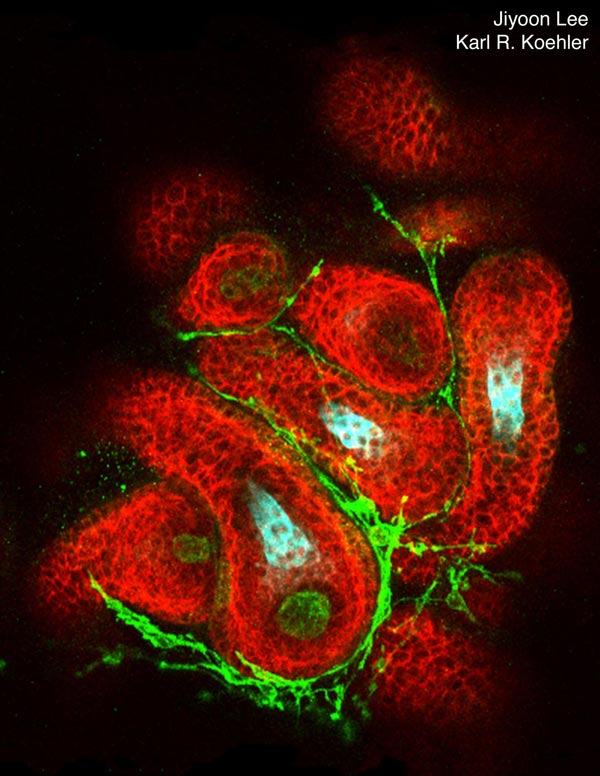In scientific first, IU researchers grow hairy skin in a dish

Lee et al. show that hair follicles can be generated from mouse pluripotent stem cells in a 3-D cell culture system. The hair follicles (red) grow radially out of spherical skin organoids and contain follicle-initiating dermal papilla cells (green cells) and hair shafts (cyan). Credit: Artwork by Jiyoon Lee and Karl Koehler.
This research, recently published online in the journal Cell Reports, marks the first demonstration that hair follicles can be grown in cultures of stem cells. The study was led by Karl Koehler, PhD, assistant professor of otolaryngology-head and neck surgery at IU School of Medicine, and a postdoctoral fellow in his lab, Jiyoon Lee, PhD.
“The skin is a complex organ that has been difficult to fully recreate and maintain in culture for research purposes,” said Dr. Koehler, who explains more in a blog post. “Our study shows how to encourage hair development from lab grown mouse skin, which has been particularly troublesome for researchers to recreate in culture.”
Dr. Koehler and his team's findings build on their past work creating a technique for growing inner ear cells from stem cells, in which mouse stem cells are cultured in a three-dimensional ball and treated with specific signaling molecules to coax the cells into producing inner ear tissue. The researchers noticed that skin was a byproduct of the inner ear growth process.
“In the developing embryo, the inner ear comes from the same layer of cells as the top layer of the skin, [the epidermis], so it was no surprise that skin and inner ear tissue formed in tandem,” Dr. Koehler said. “We were surprised to find that the bottom layer of the skin [the dermis] also develops.”
In the current study, Dr. Koehler and his team show how the epidermis and dermis cells form a sphere-like cluster of cells, called a skin “organoid.” The cells in skin organoids are organized much like cells in normal skin, but inside-out, meaning the top layer of the skin faces the interior of the organoid.
The team identified culture conditions that allowed skin organoids to proceed through the stages of development much like skin in the embryo.
“After about 20 days, we were amazed to see that skin organoids sprouted hair follicles,” Dr. Koehler said. “The roots of the follicles protrude from the skin organoids in all directions.”
The researchers confirmed that the timing of development and expression of key proteins closely match skin and hair development in the mouse embryo. To validate their findings, the IU team collaborated with Stefan Heller, PhD, Edward C. and Amy H. Sewall Professor of Otolaryngology-Head and Neck Surgery at Stanford University, whose lab members confirmed that the technique was reproducible with stem cells from other mouse strains.
“In addition to the major epidermal and dermal cell types we also found specialized cell types, such as melanocytes [pigment cells], Merkel cells [touch sensing cells], adipocytes [fat cells], sebaceous gland cells, and hair follicle stem cells in organoids,” Dr. Koehler said. “This is fascinating because it shows that if we derive the basic building blocks of skin together in culture, then these diverse cell types will self-assemble on their own.”
Dr. Lee, first author on the study, said these findings serve as a blueprint for how to make from scratch the entire skin organ using stem cells.
“My hope is that by improving skin-in-a-dish models we can greatly diminish the sacrifice of experimental animals and ultimately help patients with skin-related issues live a better life,” Dr. Lee said.
Dr. Koehler said he cautions that there are several technical hurdles that they have yet to overcome for the skin organoid model to reach its full potential as a drug discovery tool. For instance, the skin organoids are missing immune cells, blood vessels and nerve endings found in normal skin.
“The shape of skin organoids is another problem that needs to be addressed in the future,” he said. “Because the organoids are inside-out compared to normal skin, the layers of dead cells and hairs cannot be shed as they are normally, so we need to find a way to flip the structure of skin organoids.”
Without these changes, the skin organoids have a shelf life of about a month, which is just long enough to study the complete development of mouse skin and hair.
Koehler and his team are currently using the mouse organoids as a template to derive hairy skin from human pluripotent stem cells. This work has the potential to lead to new skin grafting techniques–incorporating hair follicles–and therapies for human diseases, including alopecia, acne and skin cancers.
###
Additional researchers on the study include Pei-Ciao Tang, PhD, of IU School of Medicine; and Robert Böscke, MD, and Byron Hartman, PhD, of Stanford University. Dr. Böscke is currently at the University of Lübeck.
This research was funded by the National Institutes of Health, the Indiana Clinical and Translational Sciences Institute and the Indiana Center for Biomedical Innovation.
Media Contact
All latest news from the category: Health and Medicine
This subject area encompasses research and studies in the field of human medicine.
Among the wide-ranging list of topics covered here are anesthesiology, anatomy, surgery, human genetics, hygiene and environmental medicine, internal medicine, neurology, pharmacology, physiology, urology and dental medicine.
Newest articles

High-energy-density aqueous battery based on halogen multi-electron transfer
Traditional non-aqueous lithium-ion batteries have a high energy density, but their safety is compromised due to the flammable organic electrolytes they utilize. Aqueous batteries use water as the solvent for…

First-ever combined heart pump and pig kidney transplant
…gives new hope to patient with terminal illness. Surgeons at NYU Langone Health performed the first-ever combined mechanical heart pump and gene-edited pig kidney transplant surgery in a 54-year-old woman…

Biophysics: Testing how well biomarkers work
LMU researchers have developed a method to determine how reliably target proteins can be labeled using super-resolution fluorescence microscopy. Modern microscopy techniques make it possible to examine the inner workings…





















